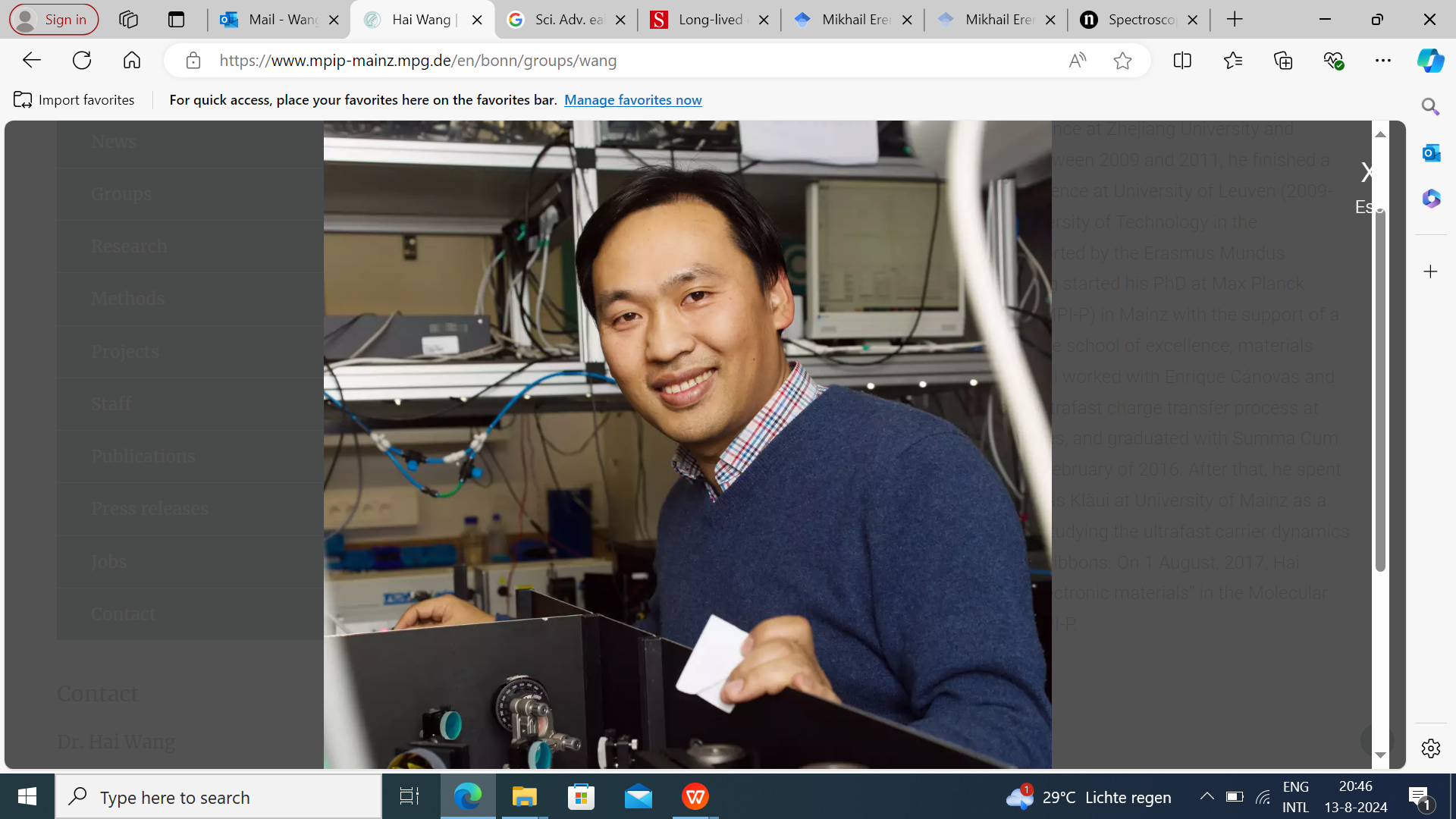乌特勒支大学&马克斯普朗克高分子研究所王海博士学术报告:Ultrafast Non-equilibrium Charge Generation and Transport in Low-dimensional Materials by THz Spectroscopy
报告题目:Ultrafast Non-equilibrium Charge Generation and Transport in Low-dimensional Materials by THz Spectroscopy
报告时间:2024年8月23日(周五),下午3:00~4:00
报告地点:光电大楼1026室
报告人:王海 博士 Utrecht University, the Netherlands & Max Planck Institute for Polymer Research, Germany
邀请人:金钻明 副教授
报告简介:
The conversion of light into electrical currents is a fundamental process underlying the operation of varied optoelectronic devices including photovoltaics and photodetectors. Understanding the underlying photophysics, e.g. generation and transport of charge carriers in the photoactive materials following photoexcitations, is crucial for improving the energy conversion efficiency of devices.
Layered two-dimensional (2D) materials are emerging building blocks for the next generation electronics and optoelectronics. Since the discovery of graphene, the family of 2D materials has been largely expanded, covering the metallic (e.g. graphene), semiconducting (e.g. transition metal dichalcogenide) and insulating phases (e.g. hexagonal boron nitride). The recent emergence of conductive semiconducting organic layers (e.g. metal covalent organic framework) has further extended the 2D material library and provided new functionalities for applications.
In this talk, I will first provide some basics on ultrafast THz spectroscopy and demonstrate its strength in characterization of electrical transport properties1 of charge carriers and low-energy excitations2 in solids in a contact-free manner for low-dimensional materials. I will then discuss some recent work from us related to the ultrafast “birth” and transport effects of charge carriers following photoexcitation by photoconductivity studies, with a particular focus on the role of many-body interactions (carrier-carrier, carrier-phonon interactions) in dictating the process of hot carrier relaxation3, transport4 and transfer5, and “lattice-dressing” effects6.
References
1. Shuai Fu et.al, Outstanding Charge Mobility by Band Transport in Two-DimensionalSemiconducting Covalent Organic Frameworks, Journal of the American Chemical Society, 2022, 144, 16, 7489–7496.
2. Alexander Tries et.al, Experimental Observation of Strong Exciton Effects in Graphene Nanoribbons, Nano Letters 2020, 20, 5, 2993–3002.
3. Wenhao Zheng et.al, Photoconductivity Multiplication in Semiconducting Few-Layers MoTe2,Nano Letters 2020, 20, 8, 5807–5813.
4. Heng Zhang et.al, Highly Mobile Hot Holes in Cs2AgBiBr6 Double Perovskite, Science Advances 2021, eabj9066.
5. Fu et.al,Long-lived Charge Separation Following Pump-wavelength–dependent Ultrafast Charge Transfer in Graphene/WS2 Heterostructures, Science Advances 2021, eabd9061.
6. Wenhao Zheng et.al, Band Transport by Large Fröhlich Polarons in MXenes, Nature Physics 2022, 18, 544-550.
报告人简介
Dr. Hai Wang studied materials science at Zhejiang University and obtained his degree in 2009. Between 2009 and 2011, he finished a joint master program in nanoscience at University of Leuven (2009-2010) in Belgium and Delft University of Technology in the Netherlands (2010-2011), supported by the Erasmus Mundus fellowship. From 2012, Hai Wang started his PhD at Max Planck Institute for Polymer Research (MPI-P) in Mainz with the support of a fellowship from MAINZ (graduate school of excellence, materials science in Mainz). In his PhD, Hai worked with Prof. dr. Mischa Bonn to investigate ultrafast charge transfer processes at quantum dot and oxide interfaces, and graduated with Summa Cum Laude (with highest honors) in 2016. After spending 1 year in the group of Mathias Kläui at University of Mainz as a postdoc, Hai started his independent research group “Nano- optoelectronic materials” in the Molecular Spectroscopy department at MPI-P in 2017, and further moved to Utrecht University as an (tenured) assistant professor. Employing time-resolved, ultrafast spectroscopies (THz spectroscopy, transient absorption etc.), the central theme of Hai’s current research lies in understanding fundamental charge carrier dynamics and low-energy excitations in solid-state low-dimensional materials and interfaces, relevant for energy and optoelectronic applications.




